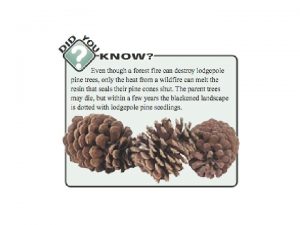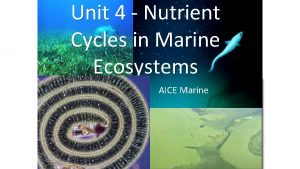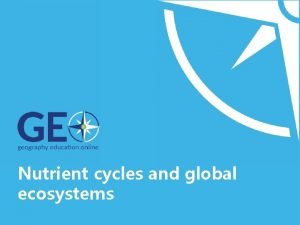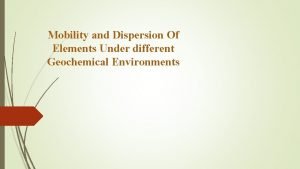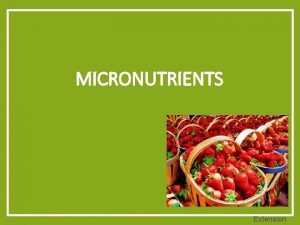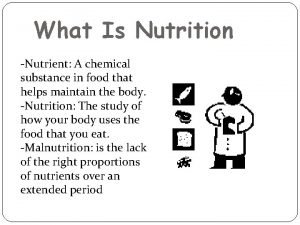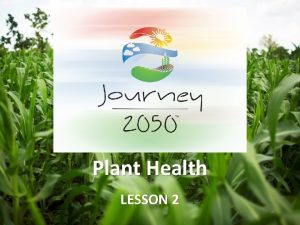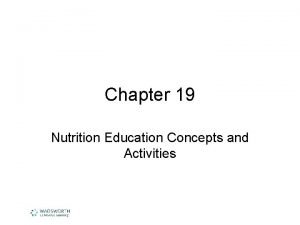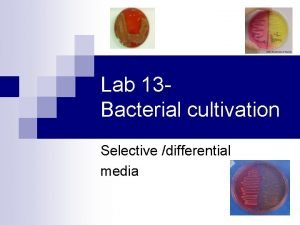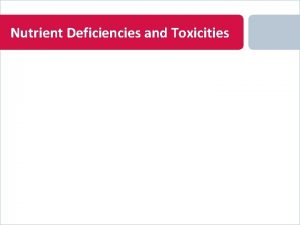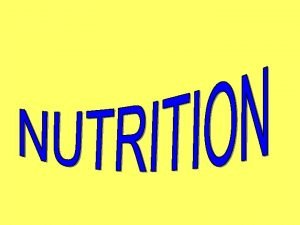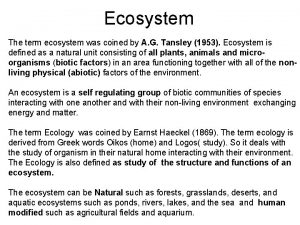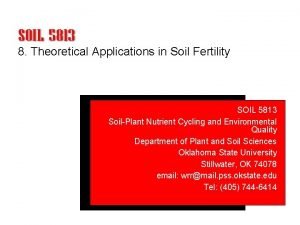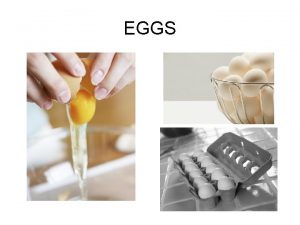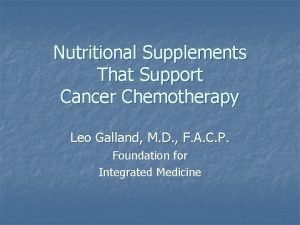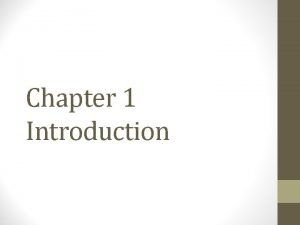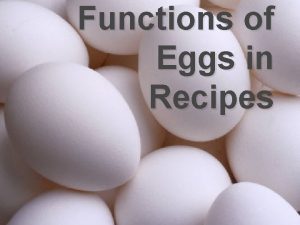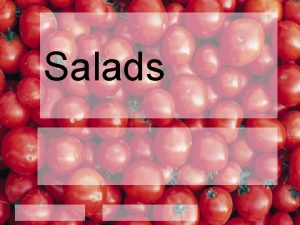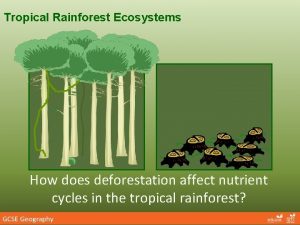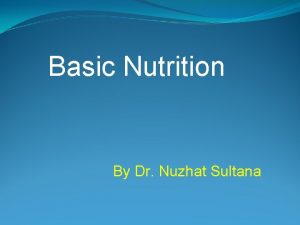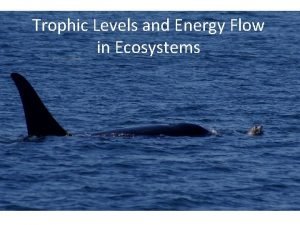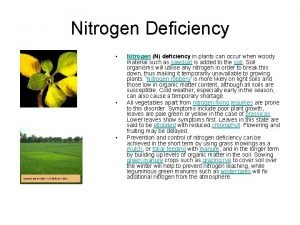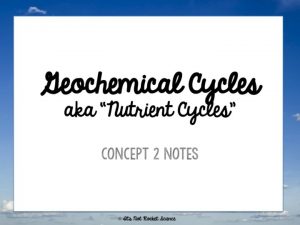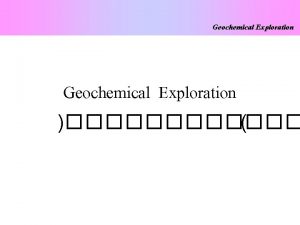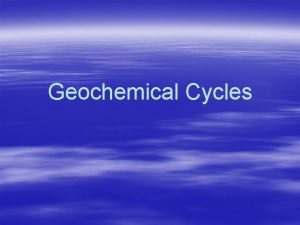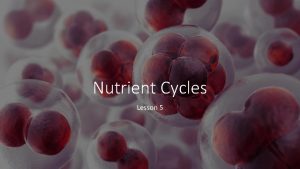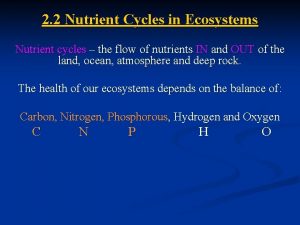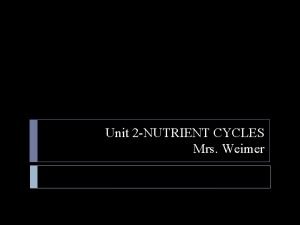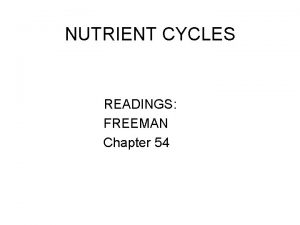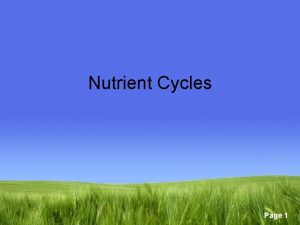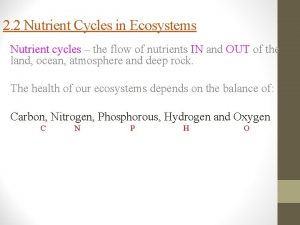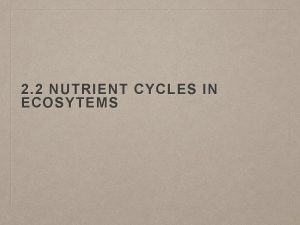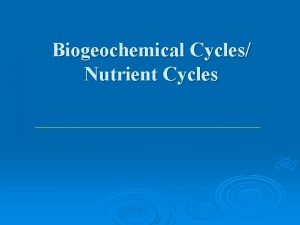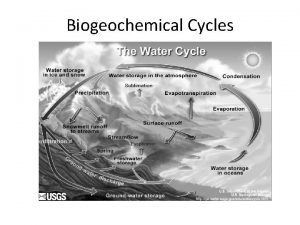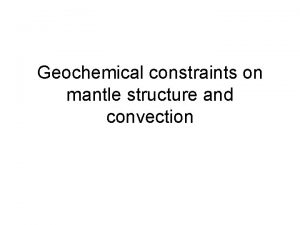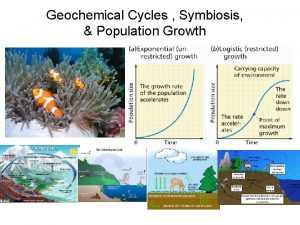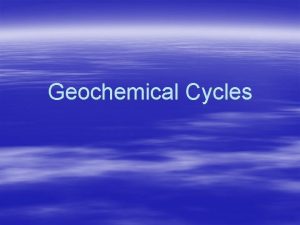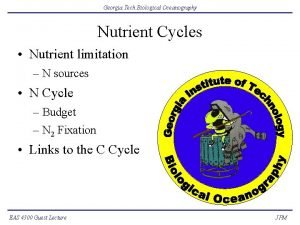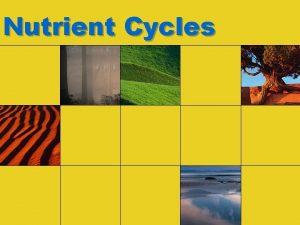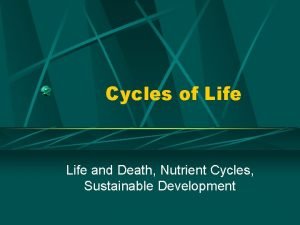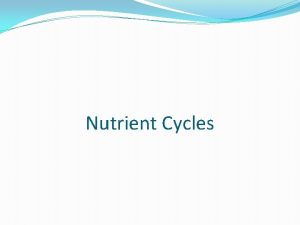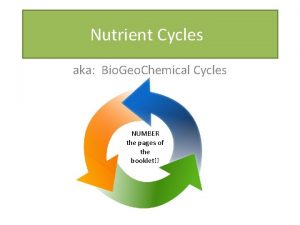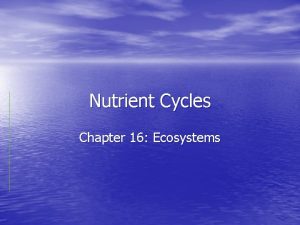NUTRIENT CYCLES GEOCHEMICAL CYCLES Movement of a particular































- Slides: 31

NUTRIENT CYCLES

GEOCHEMICAL CYCLES Movement of a particular form of matter through the living and nonliving parts of an ecosystem Earth is a closed system…must continually recycle essential matter (Matter is neither created nor destroyed)

THE CARBON CYCLE n Carbon is especially important to living systems because it is the key ingredient in all living organisms…Proteins, carbohydrates, lipids, nucleic acids

PROCESSES IN THE CARBON CYCLE Photosynthesis n Respiration n Decomposition of plants and animals n Conversion of biochemical compounds n

OTHER PROCESSES IN THE CARBON CYCLE n Combustion n When wood or fossil fuels are burned, CO 2 is released into the atmosphere

OTHER PROCESSES IN THE CARBON CYCLE n Weathering of carbonate rocks Bones/shells fall to the bottom of oceans/lakes & are incorporated into sedimentary rocks n When they decompose, Carbon is released into ocean, atmosphere n



THE NITROGEN CYCLE Why do we need nitrogen? n Nitrogen is necessary for organisms to make amino acids… …which are needed to build proteins!!! n

NITROGEN RESERVOIRS In the atmosphere as elemental nitrogen (N 2) n 78% of the air is N 2 gas n In living organisms as proteins or nucleic acids n In organic materials that compose soil n

PROCESSES IN THE NITROGEN CYCLE n NITROGEN FIXATION: Nitrogen fixing bacteria-found in soil, root nodules of plants n Convert elemental nitrogen into forms that are available for use by plants n They “fix” it for the plants n

PROCESSES IN THE NITROGEN CYCLE n NITROGEN INTAKE: Plants take in nitrogen through root systems in the form of ammonia or nitrate n This is how nitrogen enters the food chain. n

PROCESSES IN THE NITROGEN CYCLE n DECOMPOSITION: When an organism dies or animals produce waste products n Decomposers return nitrogen to the soil n

PROCESSES IN THE NITROGEN CYCLE n DENITRIFICATION: Denitrifying bacteria break down nitrogen compounds in the soil n Release elemental nitrogen into the atmosphere n “De” undo, reverse n




THE WATER CYCLE AKA: THE HYDROLOGIC CYCLE Water is a necessary substance for the life processes of all living organisms

THE WATER CYCLE AKA: THE HYDROLOGIC CYCLE n PRECIPITATION: n. The process in which water (in the form of rain, snow, sleet, or hail) falls from clouds in the sky.

THE WATER CYCLE AKA: THE HYDROLOGIC CYCLE n EVAPORATION: n n Water changing from a liquid to a gas TRANSPIRATION: n Evaporation of water from a plant’s leaves

THE WATER CYCLE AKA: THE HYDROLOGIC CYCLE n CONDENSATION: Water vapor (a gas) in the air turns into liquid water. (Condensing water forms clouds in the sky. ) n As water vapor condenses— impurities (such as dust) are removed from the atmosphere and fall to Earth with precipitation n

THE WATER CYCLE AKA: THE HYDROLOGIC CYCLE n ACCUMULUATION: n n Water pools in large bodies (oceans, seas and lakes). SEEPAGE: n Water entering the ground

THE WATER CYCLE AKA: THE HYDROLOGIC CYCLE n RUN-OFF: As water travels through soil and rock, it is physically filtered of impurities (filtration) n Water flow slows—heavier particles settle out and purified water continues toward oceans n

THE WATER CYCLE AKA: THE HYDROLOGIC CYCLE n Also remember… Water is also returned to the environment during cellular respiration! C 6 H 1206 + O 2 CO 2 + ATP + H 2 O n



O 2 -CO 2 balance…plants need to produce enough O 2 n Oxygen produced by plants is also responsible for the ozone layer n n Prevents much of the Sun’s UV radiation from reaching Earth’s surface

The story of my fish tank…

AMMONIA (NH 3) is released through respiration & excretion Ammonia is very deadly in high concentrations—so enough fish producing ammonia in a small space (like an aquarium)…will kill the fish.

n Well, this doesn’t have to happen… Bacteria present in an aquarium will feed on ammonia producing nitrites…another bacteria will feed on nitrites producing nitrates… n Nitrates are not nearly as harmful, and much, much easier to control. You would need OBSCENE amounts for it to do any real damage. n

 Practice geochemical cycles answer key
Practice geochemical cycles answer key Transport medium examples
Transport medium examples A terrestrial food web
A terrestrial food web Biogeochemical cycles apes
Biogeochemical cycles apes Nutrients cycle
Nutrients cycle Primary dispersion
Primary dispersion What is locomotor in dance
What is locomotor in dance Non-movement area
Non-movement area Deciduous woodlands
Deciduous woodlands Nutrient interactions
Nutrient interactions Nutrient substance
Nutrient substance Journey 2050 student handout 3 crossword puzzle
Journey 2050 student handout 3 crossword puzzle Foods used in nutrition activities should be nutrient-dense
Foods used in nutrition activities should be nutrient-dense What nutrient cushions vital organs
What nutrient cushions vital organs Nutrient artery
Nutrient artery Non fastidious definition microbiology
Non fastidious definition microbiology Nutrient deficiency
Nutrient deficiency A chemical substance in food that helps maintain the body
A chemical substance in food that helps maintain the body Distal border of extended thumb
Distal border of extended thumb The term ecosystem was coined by *
The term ecosystem was coined by * Brays nutrient mobility concept
Brays nutrient mobility concept Are eggs nutrient dense
Are eggs nutrient dense Tamoxifen nutrient depletion
Tamoxifen nutrient depletion Brays nutrient mobility concept
Brays nutrient mobility concept Why is egg an emulsifier
Why is egg an emulsifier Nutrient basics
Nutrient basics 4 types of salad
4 types of salad How does deforestation affect the nutrient cycle
How does deforestation affect the nutrient cycle Dr nuzhat sultana
Dr nuzhat sultana Energy in trophic levels
Energy in trophic levels Nutrient chain foldable
Nutrient chain foldable Nutrient deficiency in tomatoes
Nutrient deficiency in tomatoes
